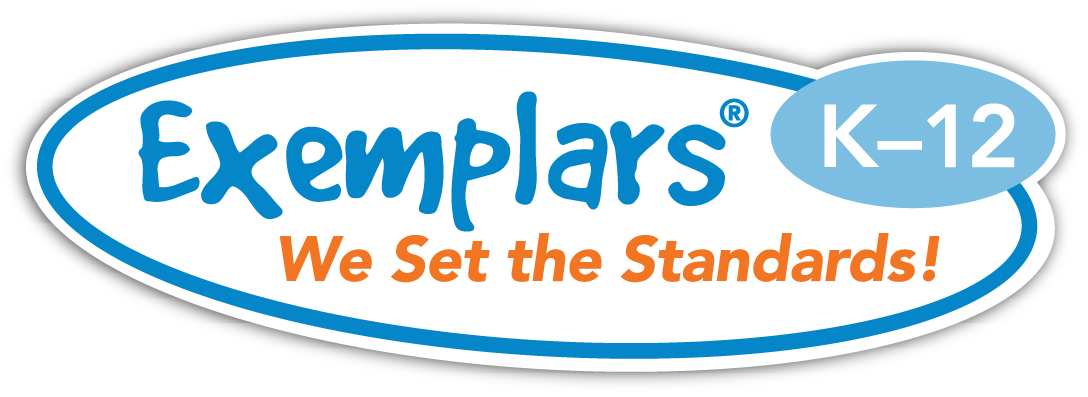Weaving SEL into Exemplars Problem-Solving Process
A Helpful Guide and Resources
Contributors: Tess McCafferty, Teacher, OH and Sierra Smith, SEL Coach, VT
According to the Collaborative for Academic, Social and Emotional Learning (CASEL), Social Emotional Learning (SEL) is the process through which all young people and adults acquire and apply the knowledge, skills, and attitudes to develop healthy identities, manage emotions and achieve personal and collective goals, feel and show empathy for others, establish and maintain supportive relationships, and make responsible and caring decisions.
CASEL has identified five core areas of social-emotional competence:
Self-Awareness | Self-Management | Social Awareness | Relationship Skills | Responsible Decision Making |
The ability to understand one’s own emotions, thoughts, and values and how they influence behavior across context. | The ability to manage one’s emotions, thoughts, and behaviors in different situations and to achieve goals and aspirations. | The ability to understand the perspectives of and empathize with others, including those from diverse backgrounds, cultures, and contexts. | The ability to establish and maintain healthy and supportive relationships and to effectively navigate situations with diverse individuals and groups. | The ability to make caring and constructive choices about personal behavior and social interactions across diverse situations. |
As we think about how and when to teach and reinforce these competencies, it becomes apparent that rich, rigorous tasks that draw on collaboration are a perfect setting for SEL growth and development. Exemplars Ambassador, Frances Zale, writes, “The agendas of both the CASEL and Exemplars pedagogies strive to create classroom cultures that are heavily student-focused and driven on personal growth. This formula strives to be collaborative for students; where they are seen as partners in the classroom learning process.”
Below, we have created a tool you can use to seamlessly weave SEL practices into your Exemplars lessons. Aligned to our Problem-Solving Process, the tool suggests routines for each step along the way, as well as additional Getting Ready and Reflect ideas for before and after. A printable PDF version is available for you to post in your classroom or save in student folders or binders along with the Problem-Solving Process.
For more information about the connections between Exemplars problem-solving tasks and Social Emotional Learning, check out guest blogs “Calculating a New Kind of Mathematical Agenda” and “Grow Student Confidence Through Problem Solving” written by Exemplars users.
How am I feeling? - Self-Awareness
It is helpful for students to take a moment before beginning a difficult task to check in with themselves and consider how they are feeling – on that particular day and about the task itself. This will help with the What Do I Need? question that follows.
What do I need? - Self-Management
Teachers can help students think of things they can do to feel ready to begin a difficult task. Ideas might include a movement break, calming break, or getting a drink of water. Students needing more support might look to their schedule and plan their next break. Teachers can post acceptable ideas in the classroom for students to see and use.
How Hard? - Self-Management
On a scale from 1 to 5 (with 5 being the most difficult), how hard do you think this work is going to be? Write that number down or keep it in your head.
Get Organized - Self-Management
Ask students, “What do you need to successfully complete the task?” Students can make sure they have what they need, and only those things, at their work space. Students needing more support might look at a photo of a task-ready working space to get set up.
Set a Goal - Self-Management
Students can be supported to think about what they want to accomplish by the end of the task. Goals could be connected to the Exemplars Jigsaw Rubric (I want to make sure my representation has appropriate labels.) or not (I want to use my best handwriting.)
Positive Thinking Plan - Self-Management
Before starting a difficult task, students can pick a positive thought (“I can do hard things,” “I’m getting smarter every day,” or “Mistakes grow my brain” are good examples. Other ideas for creating Positive Norms can be found here) to use if and when things become difficult. It may help to write the positive thought down and keep track of when it is used.
3 Reads - Self-Awareness, Self-Management
Exemplars recommends using a close reading strategy like the 3-Reads technique in order to understand what a complex problem is actually asking. Some students may benefit from an even more specific checklist in order to guide them through the “Understand” step (red section) of the Problem-Solving Process, especially if they are tasked with completing a problem on their own. This checklist will help them monitor their own understanding and give them the confidence they need to begin the problem. The checklist may also give them a better idea of where specifically they need assistance comprehending the problem.
Students who struggle with reading, special education students, or students who need help with organization could have a laminated copy of this in their math folder and use a dry erase marker to walk themselves through the Understand step.
3 Reads Checklist
Classroom Norms and Talk Moves - Social Awareness, Relationship Skills
Before engaging in problem-solving routines as a class, it is important to establish a culture of collaborative problem solving. Having students work together to come up with classroom norms will help them take ownership over their community. Posting the agreed-upon norms for students to see can act as a good reminder of the expectations for all.
Similarly, teaching appropriate and helpful ways to contribute to an academic discussion may help students to focus their attention and feedback. Talk Moves or Sentence Starters can help focus whole-group and small-group discussions on ideas and understanding rather than judgment.
Examples - Classroom Norms
Students, you have the right to: | Students, you are obligated to: |
|---|---|
Make a contribution to an attentive, responsive, audience. | Speak loudly enough for others to hear. |
Ask questions. | Listen for understanding. |
Treat everyone civilly. | Agree or disagree (and explain why) respectfully in response to other people's ideas. |
Have your ideas discussed, not you. |
Examples - Student-Owned Talk Moves:
Wait time … | Can you repeat/rephrase that …? | Agree/Disagree and Why? |
Say more … | What evidence can you share …? | Adding on or Piggyback |
So you’re saying … | Counter/Challenge: Is that always true? | Can you explain what they mean? |
Adapted from:
Michaels, S., Shouse, A. W., & Schweingruber, H. A. (2007). Ready, set, science!: putting research to work in K-8 science classrooms. National Academies Press. Pages 87-108.
Small Group Roles/Responsibilities - Social Awareness, Relationship Skills
If students are working in small groups to solve an Exemplars problem-solving task, teachers and students could co-create a list of class roles and responsibilities for each member of the group. These roles and responsibilities could highlight different students’ strengths and weaknesses so that all can contribute to the group in a meaningful way.
Possible roles/responsibilities:
- Recorder: This student is responsible for recording the group’s thinking (drawing diagrams, writing explanations, etc.)
- Materials Manager: This student is in charge of organizing and displaying manipulatives for the group. They listen to the group’s thinking and use the chosen manipulatives to showcase for the group.
- Speaker: If/when the group is sharing their thinking with the class, this student(s) acts as the spokesperson for the group and shares with the rest of the class.
- Time-Keeper: This student makes sure the group stays on track and is aware of the time limitations of the task.
- Rubric-Checker: This student makes sure the group has all of the information/thinking that is needed to hit their target score/level on the rubric.
These roles/responsibilities would be assigned/chosen during the Think step (yellow section) of the Exemplars Problem-Solving Process while students are coming up with their plan. Students may decide on their roles as a group or they could be assigned a role by their teacher.
Get Help When You Need It - Responsible Decision Making, Relationship Skills
In order to be successful with Exemplars, students must be able to ask questions of their peers and/or teachers and ask for help when they need it. The following sentence starters/prompts could be taught and modeled in classrooms at the beginning of the year and used throughout the use of the Exemplars program. Students who struggle with social/emotional skills could have a printed copy of these prompts in their math journal or folder to use when needed.
- I’m struggling with _____. Can we talk about it later?
- I’m working hard, but I’m still not understanding _____. Can you help me?
- I’m not sure what I need. Can you please talk with me?
- Can you give me advice about _____?
- “Can you show me again?”
- “Can I have a little extra time?”
- “Can you help me know when I’m running out of time?”
- “Is there somewhere else I can go to finish my work?”
- “Can I have more space to show my work?”
Depending on your classroom routines, students may ask for assistance by:
- Raise Hand
- And wait for the teacher
- Hand teacher a note
- Write it down and pass it
- 3 Before Me
- Ask 3 friends first
- Give a signal
- Plan a “help” signal with the teacher
- Look at my resources
- In your notebook and around the class
Sources:
understood.org
eduotopia.org
Chunk It- Responsible Decision Making
Some students may benefit from doing a bit of the task, and then taking a break.
Time It - Responsible Decision Making
Some students may benefit from a timer. Students can set the timer for an agreed-upon amount of work time, see how far they get, and repeat.
Preview It - Responsible Decision Making
Some students may benefit from seeing a task the day before it is given in class.
Practice It - Responsible Decision Making
Working on a non-permanent surface, like a whiteboard, may help students initiate and persevere with difficult tasks.
Work with a Buddy - Responsible Decision Making
If it isn’t already part of the working structure of the class, some students may benefit from working together to remain on task and persevere.
Fill In the Loading Bar - Responsible Decision Making
Similar to the chunk-it routine, this helps students work toward a goal before taking a short break. Students can have a “Loading Bar” with an agreed upon number of sections on their desk. When a portion of the task is completed, they can fill in one section of the loading bar. When the bar is full, they can take a short break.
Match the Sample - Responsible Decision Making, Self-Management
We want our students to be able to look at their own work with a critical eye and make corrections and improvements that not only prove their answer is correct, but that also take their work to the next level. For some students, especially those in need of a lot of social/emotional support, completing rigorous tasks like an Exemplars task and then being asked to go back and review their work can seem overwhelming.
In the “Review” portion of the Problem-Solving Process, students are asked the following questions:
- Did you show your thinking?
- Did you state an answer?
- Did you use at least 2 terms and/or symbols?
- Did you make an accurate representation?
It would be helpful for both teachers and students to have different visuals and/or resources set up in the room that students are able to access independently to check their work against. If taught, modeled, and revisited throughout the school year, students would understand and be empowered to review their work with purpose and make informed decisions about making changes to their work. Here are some resources that teachers could have available for students in their rooms:
Did you show your thinking?
| |
Did you use at least 2 terms and/or symbols?
| Did you make an accurate representation?
|
Glow and Grow - Self-Awareness, Self-Management
The Exemplars Jigsaw Rubric is a great tool for students to use to self-assess their work. The rubric can also be used to reflect on where students are in their current mathematical practice and set goals for themselves in future tasks. After students have compared their self-assessment on the rubric with their teacher’s assessment, students can complete a quick “Glow and Grow” chart. This chart will allow students to look at the different areas of the rubric and decide whether that is an area they did well in (Glow), or if that is an area they need to focus more on next time (Grow). Students can use images of a sun if they feel that is a “glow” area for them, and a flower if it's an area that has room for improvement or “grow.”
Teachers can display this chart in the classroom and have each student place a sun and flower with their name on it on the section they have deemed their “glow” and “grow.” This chart can be used to monitor progress towards a class goal, or to choose partners/groups for future Exemplars tasks. Students who feel they are strong in certain areas can be grouped with students who are struggling with that part of the rubric but have a different strength to bring to the group. Teachers can also have individual charts printed for students to keep for themselves and monitor their growth over time.
How Do You Feel? - Self-Awareness
After completing a difficult task and working hard, students can reflect on how they feel and compare it to the answer they gave to the same question at the start of the task.



